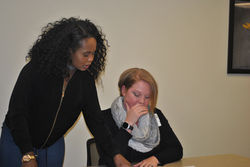
Project Investigators

Sheila Grigsby

Roxane Vandermause
 |  |
|---|---|
 |  |
 |  |
 |  |
WEEKLY LESSONS
 |  |
|---|---|
 |  |
 |  |
EAST ST LOUIS, Ill – On a clear spring day, the four-year-olds laughed as they ran out on the playground at the start of morning recess. Within minutes, one boy stopped, a terrified look on his face. Brenda Crisp and her staff immediately realized what was happening: Asthma attack.
He escalated from zero symptoms to a severe attack in no time at all,” said Crisp, director of the Uni-Pres Kindercottage daycare center. “It came out of the clear blue.
Background
Racial disparities regarding chronic disease, health disparities and mortality have been well documented in the St. Louis Region. This project will answer the following questions: What are the priority health disparities for African-American St. Louis youth? What community proposed strategies will reduce these health disparities?
This project will answer the following :
Aims:
1) Develop a consortium among two St. Louis area FQHCs, an area hospital, a private clinic, a university partner, community-based organizations, and schools;
2) facilitate patient-centered discussions on problems and solutions; 3) educate partners on PCOR process; and 4) develop neighborhood toolkit for dissemination.
The state of health for African-Americans is especially precarious. Chronic disease has an excessive impact on minority populations. Consider these facts:
-
The prevalence of diabetes among African Americans is about 70% higher than among white Americans.
-
Infant mortality rates are twice as high for African Americans as for white Americans.
-
The 5-year survival rate for cancer among African Americans diagnosed for 1986-1992 was about 44%, compared with 59% for white Americans.
Asthma is a top priority but we would love to expand our program. Feel free to comment and let us know what you think is the real prioty health problems. Just click on Comment .








